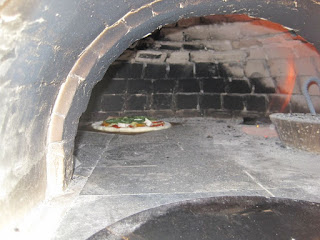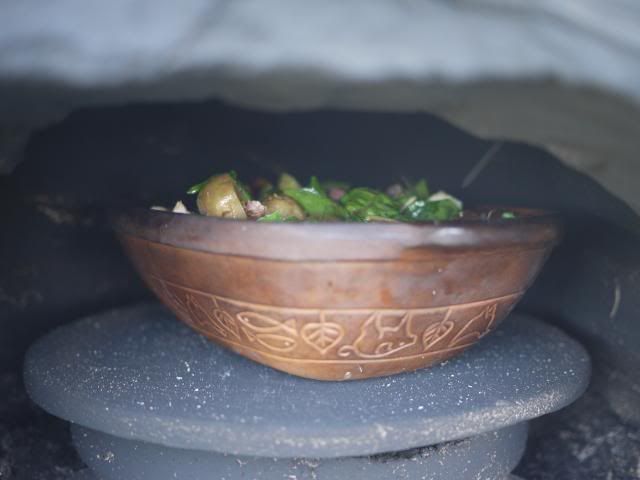|
|
Post by patamos on Oct 14, 2014 8:42:18 GMT -8
Cool thread y'all. Thanks.
I'm getting ready to finish off a L-feed oven and am fathoming how low to place the exhaust port to achieve some bell effect with the top of the oven. Don't want it lower than the door though so as to avoid blasting the user with a wave of gases when they open the door. Matt, do you notice any such effect when you open your door?
Wisco, if you are charging the oven entirely with a pre-burn then you may as well set the exhaust port(s) as low as possible to keep the gasses in there as long as possible wihtout stalling the draft. Chimney height can pull things along and, as Donkey suggests, start ups with the door open can serve as an effective bypass flue.
Pre-burn ovens with entirely radiant/conductive heat are great for baking bread because the moist air can be sealed in while baking. HOwever, they take a while to pre-heat and then offer a gradually diminishing release of the heat. So your sequencing of what you cook and when is predetermined. The length of flywheel will be determined by how hot your fire is and how much mass you are charging.
Otherwise the cooking-while-firing is WAY more versatile. Convection heat gets things happening right away, and radiant/conductive follow along.
Unless baking fine breads is your thing, i'm agreeing with the experts here, live firings are the way to go.
well being
pat
|
|
|
|
Post by wiscojames on Oct 14, 2014 8:53:38 GMT -8
Thanks! I appreciate the thoughtful response regarding the chimney. In the end, I may need to build both. I really like the idea of cooking over a live fire, but also like the idea of charging an oven's mass up and being able to bake bread in it at a stable temperature, without too much fuss.
|
|
|
|
Post by matthewwalker on Oct 14, 2014 9:14:01 GMT -8
Hi Pat, whether or not the door blasts hot gas out depends on how things are set. I have a couple dampers on the exhaust. One on a bypass from high up in the second bell/barrel, and one in the stack itself. When I am trying to cook hot, I'll have the first closed and the second damped down quite a bit. In that case, if the cooking adjustment baffle is open, yes, the oven will blast out the door. I try not to let it do that much, so typically I'll at least close the cooking baffle when opening the door.
I agree with all you said. Keep in mind my design can work just as well either way. You can open it up all the way, heat up the oven, and let things go out and cook off of the latent heat. Mine has a moderate amount of mass, with a fair bit of insulation. If you built with a larger mass, it would function exactly like a traditional oven. There's also no reason at all you couldn't build a fire in it if you wanted to go full traditional as Thick Strings mentions. Only downside to building it in that manner is that you need to put a lot more energy into it, so there's a compromise there to think about, depending on how you want to use it. Mine is fairly lightweight for quick response and low input cooking, but that's a choice.
|
|
|
|
Post by patamos on Oct 14, 2014 20:39:47 GMT -8
Hi Matt, Ya very good point about cooking with latent heat after the rocket fire has gone out. So long as the exhaust flue can be closed off most any rocket-fired oven with a moderate amount of mass in the dome ought to bake the same high quality bread... Your approach looks optimal in many ways  Just wanted to make sure Wisco was appraised of the different principles at play. Matt, when your exhaust dampers are open how much less heat comes out the door as you open it? (I'm deciding tomorrow what height to build an oven's exhaust port, so hope y'all don't mind me trolling in a bit off topic...) well being pat |
|
|
|
Post by matthewwalker on Oct 14, 2014 21:22:14 GMT -8
When it's tuned right it doesn't really put any exhaust out the door with the dampers open. Originally I had two 6' lengths of chimney and that was too much, it drew in at the oven with all dampers open, and even with 'em closed was hard to get it much above 500°F, which was important to me for cooking pizza. Once I took off a length of chimney, it became much easier to get hot, but still doesn't really exhaust out the door with chimney dampers open and cooking baffle closed.
|
|
|
|
Post by ronyon on Oct 15, 2014 6:48:13 GMT -8
Concerning bread and a moist atmosphere, how about a drip feed of water into the oven? have it hit a metal plate , vaporizing instantly,use an in line valve for adjusting the rate.
Personally I bake no knead style, which has lots of water in it and is baked in a closed container, thus steaming itself for a great crust, but a steam oven is something to aspire to, and with no gas or electric to make things tricky, a little trickle or drip of water into the oven itself could make for great baking.
|
|
|
|
Post by matthewwalker on Oct 15, 2014 8:28:41 GMT -8
It's pretty common to mist ovens for the crust when baking things like french bread. I bake no-knead sourdough pretty much every day Ronyon, and when I bake it in the outdoor oven I don't use a container. The moisture fogs the window on the door and the crust comes out amazing, even without the container. It's one reason why I don't care for metal as the inner lining in outdoor ovens. Gotta be masonry for me, to absorb some moisture and then give it back as the bread cooks. That's my theory, anyway.
When I bake indoors, I put a small bread pan inside a dutch oven, then put the whole works in the oven. Gives me good loaf shape but still in the no-knead container style.
|
|
|
|
Post by wrekinwanderer on Oct 31, 2014 14:12:39 GMT -8
Hey Matt, a question.
How big is the hole at the base of your oven on the barrel?
Mike
|
|
|
|
Post by matthewwalker on Oct 31, 2014 15:13:00 GMT -8
Mike, it's a 4" hole. Here's a crappy diagram...  |
|
docbb
Junior Member
  Back from ZA
Back from ZA
Posts: 92
|
Post by docbb on Nov 1, 2014 6:44:58 GMT -8
Love the system, Matt. I want one. Yesterday. So that might very well be a project next summer, but for now I am rushing to try to get one small project completed. Hard frost last night, and it's only a matter of time before we get sucked into another polar vortex. (Oh, to have the Pacific Northwest climate...) So I have my mud batch box in place, plan on building an insulated riser atop it, then a mud oven on top of that. No barrel, no bench (I had thought of harvesting the residual heat in a small bench, but it is not at a convenient height for that.) So, if you were only doing that small project, a simple mud oven, fired from below, would you go chimney-less, with a chimney in the center of the top of the oven with a deflector plate to slow the exit of hot gasses, or a chimney low on the side of the stove, along with some sort of deflector plate that would direct the entering heat away from the exit? (and maybe a deflector plate to slow the exit) Or??? May be have a look at these pages 
part 1part 2movable demoand this one in japanese-english-google tanslation

|
|
|
|
Post by wrekinwanderer on Nov 3, 2014 11:09:09 GMT -8
Hi Matt, thanks for the picture.
Do you have a hole at the base of the oven also? I remember seeing you sending in some smoke in one of your videos...
Mike
|
|
|
|
Post by matthewwalker on Nov 3, 2014 11:33:20 GMT -8
Yes, I cover most of the top of the barrel with cob, with the exception of the hole. The oven sits on that, and has no bottom. Then there is an insulated refractory diffuser plate on stand offs over the hole, and a pizza stone on top of that for a cooking surface. That configuration sends the exhaust out to the perimeter of the oven, much like the ports in Glenn's and Donkey's builds. It also allows me to use a baffle to adjust the opening size and control temps. My latest build has the control to that external to the oven, so it basically has a temp control. Let's see if I can find a photo that shows that... I can't find one of the baffle control, but here's the diffuser set up....  |
|
|
|
Post by wrekinwanderer on Nov 12, 2014 12:07:02 GMT -8
Hi Matt, I do love your system, not to mention your generosity and patience with sharing the results of your experiments on this forum!
I have a small cast iron oven that I picked up on ebay a while ago, similar, if not identical to the picture on page 1 of Robert's thread. (http://donkey32.proboards.com/thread/977/tube-rocket-bell-oven) I am currently undecided as to whether to install it in a bell, like Robert or whether to place it just above the barrel itself with a damper controlling the temperature a la Matthew Walker. Either simply as a Dutch oven or without its cast iron bottom, and hence gases in....
I have some more questions for you, if you don't mind....
Okay, so the hole in the barrel above the riser is acting as both intake and exhaust and is smaller than csa. Did you mess about with different size holes before you came up with the 4" diameter?
Hmmmm,I'm going to be incorporating my oven into a heated half barrel bench, well 3 half barrels, and then up 6m flue pipe to the roof, so a little disconcerted to see that you couldn't get the oven really toasty with 12foot of chimney! Although saying that 500F, not bad! Any suggestions?
Best wishes, Mike
|
|
|
|
Post by matthewwalker on Nov 12, 2014 14:46:39 GMT -8
No problem on the questions, in case you didn't notice, I love this stuff!
On hole size, there is some evidence that smaller than that won't work well, I would imagine there's no limit on how large you make it.
Oh, the chimney thing is easily regulated with a flue damper in the chimney. I imagine that pushing through the bench will provide just enough resistance to give good push into the oven. It's all going to depend on lots of stuff, outside temp, fire size, benches warm or cold, and so on. It will be constantly changing so you'll be tuning it as you go anyway. Don't sweat it, build it and learn it. I have no doubt it will work very well for you.
|
|
|
|
Post by wrekinwanderer on Nov 13, 2014 5:46:46 GMT -8
Yep, I had noticed your service and inspiration to Rocketeers around the world!
Another question for you: how close is your riser to the top of the barrel?
Thanks for your encouragement Matt - you're a star!
|
|